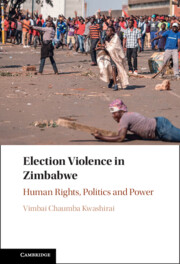Book contents
- Election Violence in Zimbabwe
- Election Violence in Zimbabwe
- Copyright page
- Dedication
- Contents
- Figures
- Tables
- Preface
- Acknowledgements
- Abbreviations
- Introduction
- 1 Violence, a Colonial Curse
- 2 Zanu PF and PF Zapu Violence
- 3 The New Enemy in the 1990 General Elections Was Zum
- 4 Zanu PF on Zanu PF Violence in 1995
- 5 What Presidential Election in 1996?
- 6 The Movement for Democratic Change Was Number One Enemy in 2000
- 7 Presidential Election in 2002
- 8 What General Elections in 2005?
- 9 Disharmony in the 2008 Harmonised Elections
- 10 Violence in the 2013 Elections
- Conclusions
- Recommendations
- Select References
- Index
6 - The Movement for Democratic Change Was Number One Enemy in 2000
Published online by Cambridge University Press: 23 February 2023
- Election Violence in Zimbabwe
- Election Violence in Zimbabwe
- Copyright page
- Dedication
- Contents
- Figures
- Tables
- Preface
- Acknowledgements
- Abbreviations
- Introduction
- 1 Violence, a Colonial Curse
- 2 Zanu PF and PF Zapu Violence
- 3 The New Enemy in the 1990 General Elections Was Zum
- 4 Zanu PF on Zanu PF Violence in 1995
- 5 What Presidential Election in 1996?
- 6 The Movement for Democratic Change Was Number One Enemy in 2000
- 7 Presidential Election in 2002
- 8 What General Elections in 2005?
- 9 Disharmony in the 2008 Harmonised Elections
- 10 Violence in the 2013 Elections
- Conclusions
- Recommendations
- Select References
- Index
Summary
In 2000, udlakela was diverse in its trail, levels, spread and types transforming, and evolving in different ways, in different places and times, and used on different people. The resurgence of violence in 2000 was categorically a response to emboldened opposition as civil society united to mount a spirited stand against Zanu PF autocracy. In September 1999, the ZCTU led by Morgan Tsvangirai in coalition with largely urban-based civic groups collaborated and formed a new opposition party – the Movement for Democratic Change (MDC). In 1999 and 2000, unprecedented nationwide political violence rocked Zimbabwe, starting during a referendum campaign for the adoption of a long overdue new constitution. The MDC defeated the government after campaigning for a ‘No’ vote in the February 2000 referendum. Held from 12 to 13 February, the result was a majority ‘no vote’. Out of a total of 1,312,738 votes cast, 697,754 were against the draft and 578,210 endorsed it. The draft constitution was rejected by 54.7 per cent against 45.3 per cent on a 26 per cent largely urban turnout. Violence in 2000 was induced by three broad issues: the referendum, land reform and the parliamentary election. These influences and the violence often coalesced but also remained distinct.
Keywords
- Type
- Chapter
- Information
- Election Violence in ZimbabweHuman Rights, Politics and Power, pp. 128 - 158Publisher: Cambridge University PressPrint publication year: 2023

